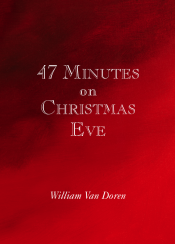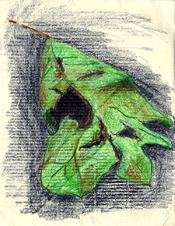Sunset, Wednesday, 22 July 2009
 William Theodore Van Doren. Stony Point, Albemarle County, Va. Oil on paper, 16 x 20.
William Theodore Van Doren. Stony Point, Albemarle County, Va. Oil on paper, 16 x 20.
Walking through a dense passage in the woods today, basically a long-overgrown jeep trail, almost everything a variation on green, plus sun and shade making two versions of each green, and having to keep my head down to get under or around all the young trees, I looked up and was startled by a blazing red sort of star resting on some bending branches of ironwood, just below eye level.
My very initial reaction, even though this thing was not magenta or orange, was, why would someone have tied a plastic property marker here of all places? In property terms, this was the middle of nowhere, almost but not quite by the river (north fork of the Rivanna) – maybe 50 yards shy of it.
Anyway, that was a fraction of a fraction of a second. The star was a fallen leaf of a Virginia creeper vine, already turned blazing scarlet with just a little residual green in a couple of places, a hint of red violet behind the scarlet, and missing one of its five long leaves. The young death of the leaf, its still supple shine, made the red that much more brilliant.
So, on further consideration, and because it was so completely different from everything else around it, the star on the ironwood looked like an asterisk, put there in the most attention-getting possible way. It looked even more like an asterisk than an asterisk normally does, because, with its color, it was literally so exceptional.
What would the footnote say, to which this asterisk referred. I figured with its autumn fire in high summer the creeper was indicating something about time.
* * * *
I hope I don’t get wound up here in strained comparisons or become guilty of attempted poetry, but I couldn’t help thinking too about the sun. The ultimate bullet.
* * * *
In trying to check against my identification of the ironwood (or hophornbeam) tree – leaves nearly like a beech but the young bark not pale, more steely gray – I had to settle for the National Audubon Society Field Guide to North American Trees. It’s helpful, but I was looking everywhere for one of my favorite discoveries, what I consider the best single tree identification source for this part of the world, Tree Finder: A Manual for the Identification of Trees By Their Leaves, by May Watts. One of the great pleasures of this book is its amazingly rigorous system, which allows for the differentiation of almost every eastern tree in a little pocket-sized guide – hardly bigger than a pamphlet – for $3.95.
 Wednesday, July 22, 2009 at 09:49PM | by
Wednesday, July 22, 2009 at 09:49PM | by  BVD | in
BVD | in  Prose,
Prose,  Sunset Paintings,
Sunset Paintings,  Sunsetology | tagged
Sunsetology | tagged  Albemarle County,
Albemarle County,  Blue Ridge,
Blue Ridge,  May Watts,
May Watts,  Rivanna River,
Rivanna River,  Stony Point,
Stony Point,  Tree Finder,
Tree Finder,  hophornbeam,
hophornbeam,  ironwood,
ironwood,  trees,
trees,  typography | | Comments Off
typography | | Comments Off 




